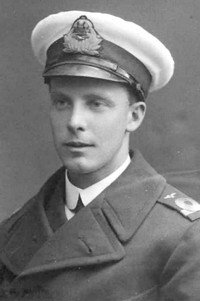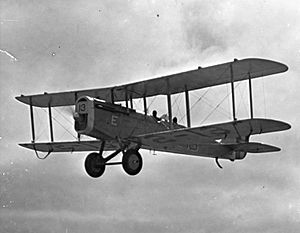Charles Bartlett (RAF officer) facts for kids
Quick facts for kids
Charles Bartlett
|
|
|---|---|

Charles Philip Oldfield Bartlett
|
|
| Born | 3 January 1889 Weston-super-Mare, Somerset, England |
| Died | February 1987 (aged 98) Cheltenham, Gloucestershire, England |
| Allegiance | United Kingdom |
| Service/ |
Royal Naval Air Service Royal Air Force |
| Years of service | 1914–1932 |
| Rank | Squadron Leader |
| Unit | No. 5 Naval Squadron RNAS |
| Battles/wars | First World War |
| Awards | Distinguished Service Cross & Bar |
Charles Philip Oldfield Bartlett (born January 3, 1889 – died February 1987) was a brave British pilot during the First World War. He was known as a "flying ace" because he shot down eight enemy aircraft. He did this while flying bombing missions against the Germans. After the war, he stayed in the military, even though he had some health problems. He served until 1932 and became a squadron leader.
Contents
About Charles Bartlett
Charles Philip Oldfield Bartlett was born on January 3, 1889. His hometown was Weston-super-Mare in England. His father was a church leader.
After his experiences in the First World War, Bartlett wrote two books. These books were called Bomber Pilot, 1916–1918 and In the Teeth of the Wind. They told the story of his time as a pilot during the war. Later in his life, he lived in Cheltenham, England. He passed away there in February 1987 when he was 98 years old.
Fighting in the First World War
Charles Bartlett joined the military at the start of the First World War. He became part of the Royal Naval Air Service. In April 1916, he officially became a pilot. He earned his pilot's certificate in June 1916.
Bartlett flew in France as a bomber pilot. He flew an Airco DH.4 plane with No. 5 Naval Squadron. He achieved his first aerial victory on July 2, 1917. This was a bonus to his main job, which was bombing enemy targets. He was awarded the Distinguished Service Cross (DSC) for his excellent work. This award was given for a bombing raid on an airfield in July 1917.
He scored more victories in early 1918. In March, he was promoted to flight commander. Later that month, Bartlett and his observer, Walter Naylor, had six more victories. They achieved these while flying bombing missions. Their success was so impressive that he received a Bar to his DSC. This means he got a second award for his bravery. One amazing event happened on March 28, 1918. He was attacked by several enemy planes. He cleverly moved his plane, causing two enemy planes to crash into each other. They both fell to the ground and caught fire.
By April 1918, Bartlett had flown 101 bombing missions. He then went to the hospital. Later, the Royal Naval Air Service joined with the Royal Flying Corps to form the Royal Air Force. Bartlett was promoted to temporary major. He left the hospital in September 1918.
After the War
Charles Bartlett continued to serve in the Royal Air Force after the war. He faced ongoing health problems. In 1919, he had to give up his military role due to sickness. However, this decision was later changed.
In 1922, he returned to full duty. He was later discharged again for health reasons. But a few days later, his discharge was cancelled once more. He then worked for six years at RAF Manston. He finally retired from the Royal Air Force on August 26, 1932. At that time, he held the rank of squadron leader.
After leaving the military, Bartlett worked as a civilian at Ruislip. In 1936, he became a bursar (a person who manages money) at Bryanston School. He later worked at Saint Dunstan's Training Center for the Blind until 1945.
List of Aerial Victories
| No. | Date/time | Aircraft | Foe | Result | Location | Notes |
|---|---|---|---|---|---|---|
| 1 | 2 July 1917 @ 1230 hours | Airco DH.4 serial number N5967 | Albatros D.V | Driven down out of control | Zeebrugge | Observer/gunner: S. D. Sambrook |
| 2 | 30 January 1918 @ 1330 hours | Airco DH.4 s/n N6001 | Albatros D.V | Driven down out of control | Engel Airfield | Observer/gunner: Walter Naylor |
| 3 | 18 March 1918 @ 1102 hours | Airco DH.4 s/n N5961 | Albatros D.V | Driven down out of control | Beaurevoir | Observer/gunner: Walter Naylor |
| 4 | 21 March 1918 @ 1804 hours | Airco DH.4 s/n N6000 | Fokker Dr.I Triplane | Driven down out of control | Honnecourt-sur-Escaut | Observer/gunner: Walter Naylor |
| 5 | 27 March 1918 @ 1045 hours | Airco DH.4 s/n N6000 | Albatros D.V | Driven down out of control | Fontaine | Observer/gunner: Walter Naylor |
| 6 | 28 March 1918 about 1000 hours | Airco DH.4 s/n N6000 | Fokker Dr.I Triplane | Destroyed | Raincourt | Observer/gunner: Walter Naylor |
| 7 | 28 March 1918 about 1000 hours | Airco DH.4 s/n N6000 | Fokker Dr.I Triplane | Destroyed | Raincourt | Observer/gunner: Walter Naylor |
| 8 | 28 March 1918 about 1000 hours | Airco DH.4 s/n N6000 | Fokker Dr.I Triplane | Destroyed | Raincourt | Observer/gunner: Walter Naylor |


